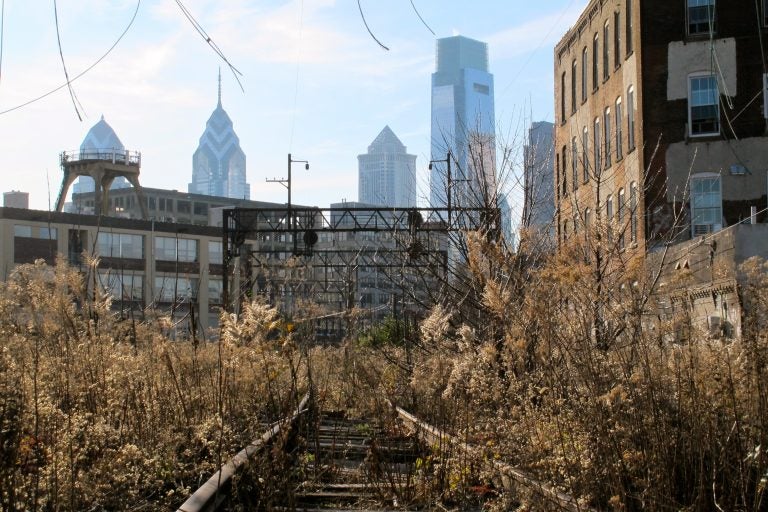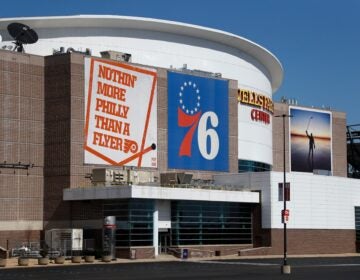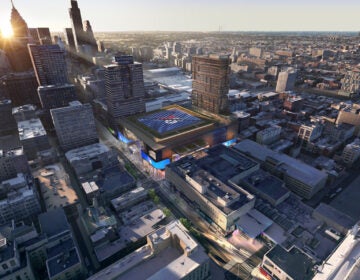In the emerging Callowhill neighborhood, making their bid for a Business Improvement District
The area could become a special taxing district that will raise funds from property owners and spend them on neighborhood-specific services.

A 2011 view of the elevated Reading Viaduct in the Callowhill neighborhood. A now-refurbished area will open as the Rail Park this month. (PlanPhilly)
The old factory district between Vine Street and Spring Garden is one of the last Center City-adjacent neighborhoods pocked by empty lots and vacant storefronts. Many have tried to name the area — Chinatown North, the Eraserhood, the Loft District, Callowhill — but it still feels like an in-between space.
In recent years, new construction has begun to transform the industrial blocks filmmaker David Lynch once called home. The June 14 opening of the Reading Viaduct Rail Park, inspired by Manhattan’s High Line, is expected to accelerate the process. But the surrounding streets are still pitted with potholes, and trash is still dumped in abandoned lots.
A handful of large property owners there, led by developer Craig Grossman of Arts & Crafts Holdings, wants to do something about those less-than-pleasant vestiges of the faded industrial era. If legislation working its way through City Council is enacted, the area will become a special taxing district that will raise funds from property owners and spend them on neighborhood-specific services.
Extra-municipal services such as security, cleaning, and beautification would be delivered through a group called the Callowhill Business Improvement District. Similar proposals have gone down to defeat in the neighborhood before, but the initiative’s backers say this time the proposed organization could be a unifying force for the area’s many identities.
“This could be a great way to bring diverse communities together for a common goal,” said Kelly Edwards, who is in charge of programming with Arts and Crafts Holdings and is spearheading the Callowhill Business Improvement District. “Pedestrian amenities popping up, better street lighting, making this a more livable and enjoyable place for residents and workers.” Enabling legislation passed through City Council’s Rules Committee last week with no opposition from either the public or the politicians. The bill contains few details about the proposed business improvement district (BID), and, if passed, it would not ensure the prospective organization’s future.
Instead, the measure would simply allow Edwards to begin meeting with the community and planning the exact geographic parameters of the BID, the services it would provide, and how much it would cost property owners.
After those conversations, a plan and budget would be mailed to every affected property owner, and a public hearing would have to take place in the community. Then the property owners would vote and, if enough backed the plan, City Council would have to approve the creation of the fully formulated Callowhill Business Improvement District.
“A lot of my time this summer will be starting that outreach and getting buy-in,” said Edwards. “I’m prepared for negative feedback. But I think we will be OK … because there’s pretty good consensus about neighborhood concerns among community groups. I’m not anticipating too much pushback.”
The only clear details the bill provides are the names of nine individuals who would serve on the proposed organizations board. They include Edwards; her boss, Grossman; developer and parking garage magnate Robert Zuritsky, who is also a member of the PlanPhilly Advisory Board; Fang Wei Pantano of United Development; and Gary Rueben, who owns the Wolf Building on 12th Street.
Board members would have to live or work in the neighborhood and would receive no compensation. Nonetheless, several neighborhood stakeholders expressed concern about the prospective composition of the board.
“The board seems to be oriented towards a business perspective,” said John Chin, executive director of Philadelphia Chinatown Development Corporation. “I didn’t hear many residents of the neighborhood. They need to have some thought towards having folks who live here and would be impacted by the new taxes of a BID.”
A 2012 attempt to organize a similar organization foundered when a group of neighborhood residents, along with community groups like PCDC, opposed the effort. It marked the first instance of a special taxing district being voted down by property owners, although since then improvement districts have been defeated in the Italian Market and near Temple University.
At this early stage, there are no declared opponents of the Callowhill proposal. Organizations that opposed the 2012 effort, like PCDC and the Asian Arts Initiative, said they do not know enough to commit to any position. But Asian Arts also expressed concerns about the proposed board’s business-heavy tilt.
Said Edwards: “The board can be amended at any time, and we are actively looking for new board members.”
Arts and Crafts Holdings’ effort to sell a Callowhill Business Improvement District to the public is strikingly different from the tactics pursued by other nascent BIDs in Philadelphia. Most recent improvement districts, like the one established earlier this year in Northern Liberties, came to public attention with detailed plans in hand. The outreach to property owners and the planning took place before a bill was presented to City Council.
That’s because those BIDs were organized under state legislation crafted in the late 1990s that required improvement districts to be organized as nonprofits. Recent legislative changes in Harrisburg allow prospective taxing districts to emulate older groups like the Center City District, which are technically organized as municipal authorities.
The model being attempted in Callowhill gives prospective BIDs an easier time securing financing for large infrastructure projects. Nonprofits like Northern Liberties’ business improvement district do not have the same standing as the City of Philadelphia when they file liens against property owners who don’t pay their dues, which makes it harder to win favorable rates from lenders when they go to the bond markets to raise capital.
For most such groups, the nonprofit model’s inability to assure lenders isn’t a huge problem because they focus on street cleaning, security cameras, and other basic services. But Center City District, for example, needs the stronger, city-like lien power because it engages in major capital projects such as Dilworth Park — and the first phase of the Rail Park. (CCD recently expanded its borders to encompass the Rail Park so that it can provide services there.)
CCD’s executive director, Paul Levy, said he has advised Edwards and Grossman. He was hesitant to make any predictions after the failure of the last improvement district in Callowhill, which he thinks was related to confusion over whether the group was being formed to provide basic services or to mastermind the Rail Park. (“Also,” Levy said, “it was a tea-party moment where people just didn’t want to pay more.”)
But now, as the Rail Park is about to open officially, Levy says, there is room for more ambitious business improvement district activity in large infrastructure projects in the future, after the new space is a known and loved part of the neighborhood. He said he advised the Callowhill Business Improvement District’s founders to organize themselves as a municipal authority, so they could potentially get involved in latter phases of the Rail Park if and when it expands.
A super-sized Rail Park, with its own BID steward, would certainly solidify this old factory neighborhood’s potential as an extension of Center City.
“Not today but maybe in five years, the authority could not only maintain the second phase of the Rail Park, it could be a participant in the multiple funding sources to get that to happen,” said Levy. “I don’t want to presume any of this actually happens, because it has to go through a planning and approval process. There’s today’s goals [basic services], and there’s what the potential power is. That’s the advantage of going this route.”
WHYY is your source for fact-based, in-depth journalism and information. As a nonprofit organization, we rely on financial support from readers like you. Please give today.







